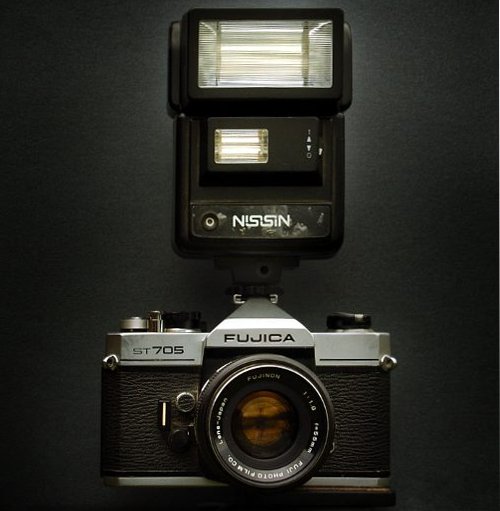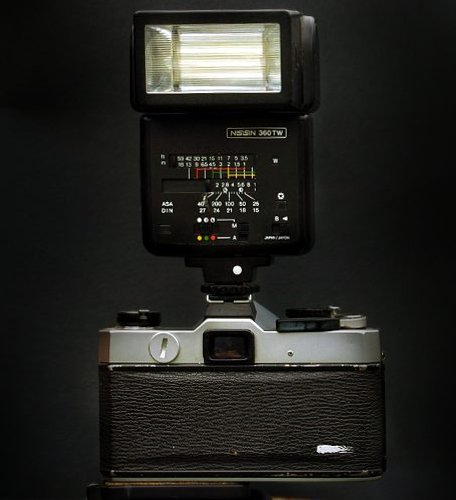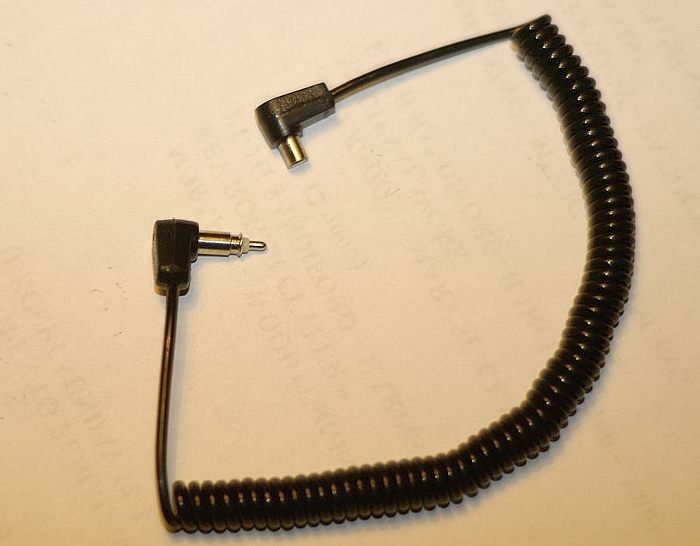
Mounted on a Fujica ST705.
from Shutter, by Lewis Collard

Mounted on a Fujica ST705.
This is the Nissin 360 TW, a semi-automatic flash made in Japan in the early 1980s. It's a great way of getting lots of flash power very cheaply (£25 or less).
Jump to: Use with digital SLRs Connection | Bounce | Trigger voltage | Batteries | Production | Weight | Weird | Accessories | Sub-reflector | Power settings | Guide number | Noise | Recycle time | What it doesn't have | Use on modern cameras | Summary | Elsewhere | Thanks
This is covered below, under connection, sync voltage, and use with modern cameras below, but the upshot is: This will work with all Nikon, Pentax, and Canon digital SLRs. Of course it doesn't work as well as a flash designed for your camera, because you will have to do manual calculations in your head to get flash exposure right, just like you would have to if you used one on a film camera.
The 360TW works better on digital SLRs than it ever did on film SLRs, in fact, because you can look at your LCD and see any exposure problems, rather than fooling around with bracketing or just hoping it worked properly. For photographs in which you have the time to do this, the 360TW works great.
It won't work with Sony SLRs, because they use a proprietary flash shoe.
Standard ISO hot shoe, screwed down by a flimsy-feeling plastic ring.
It'll fit pretty much every camera you're likely to be using in 2012 (but see trigger voltage below). It won't work on Sony Alpha digital SLRs, or post-1988 Minolta cameras, without an adapter.
It does have a PC sync socket, but apparently requires a proprietary cable from Nissin, boo. (Discussed further under Accessories.)

Shot with a Nikon D2H, Nissin
360TW at 1/16 power, Auto ISO 280, 1/250 at f/4,
car 12.6 metres (41 feet) away.
The head tilts through 180°.
The head also rotates 180° in one direction (anti-clockwise, looking from the top) and 160° (clockwise, looking from top) in the other.

For when you just have to fire your flash directly behind you.
The upshot is that you can point your flash head in just about any direction other than downwards.
10 volts is allegedly too high for Canon digital SLRs, which shouldn't use anything higher than 6 volts. I didn't set fire to any of the Canon cameras (film and digital) with which I tried it, and it worked fine, but you do this at your own risk.
This is fine on Nikon digital SLRs, which are rated for 250 volts. It should be fine on Pentax cameras as well, even though Pentax don't actually answer the question of what a safe trigger voltage is in the hope that you'll go and buy one of their flash guns. I didn't kill myself by putting it on top of my Pentax ZX-M, anyway.
Takes 4 AA batteries.
The manual (and the battery compartment says it's intended for 1.5 volt batteries. I use mine just fine with 1.2 volt Ni-Mh rechargeables, which is great because Ni-Mh didn't reach consumer applications till 1989 (7-8 years after this flash was made).

Shot with a Nikon D2H, Nissin 360TW at 1/4
power, Auto ISO 280, 1/250 at f/5.6,
car 17.8 metres (58 feet) away.
Oddly, I can't find a date that manufacturing started.
I previously said that the earliest date I had found was 1981, based on a Google Books search. But reader Paul Griffin wrote in to tell me that the original receipt for his was dated as the 27th of September, 1980 (and would have cost £39.95). I'll take 1980 as my start of production until or unless I find any earlier dates.
350 grams, specified by Nissin. You'll notice the weight on a Nikon D3100 or a Pentax K-R, less so on a big pro camera like a D3 (or a D2H).
The 360 TW actually appears to work fine on my D2H in manual mode at 1/320, which is beyond its rated sync speed of 1/250.
Also works fine at 1/250 on Canons with a 1/200 sync speed.
If you looked really close I'm sure you'd find that the very edges of the frame were unlit.
PC sync cord:

Photo courtesy of Carl Dania, a reader of my site who kindly
gave me permission to use his material here. While he owns
more modern cameras, he shot it on a Nikon D100 just to keep
with the spirit of my site! What a guy. :)
Carl Dania reports that the PC sync lead is not compatible with anything else; it's a one-off lead that works with the Nissin 360TW and probably nothing else. He also reports that if you use the lead it automatically disconnects the hot shoe contacts. I believe him on both counts.
There was a five-piece filter kit: red, yellow and blue coloured filters, a wide-angle diffuser and a telephoto condenser.
You'll have difficulty finding any of these used if they did not come with your flash. I'd only worry about the PC sync cord.
This is the small reflector on the body of the flash, underneath the primary reflector, with the 0/1 switch. Turning this on (1) will steal some light from the main reflector for the small sub-reflector.
This is useful while using the primary reflector bounced off the ceiling; it'll fill in faces that might otherwise be in shadow because of the direction of the primary flash. (Think hats.)
The manual settings are two f/stops apart each.
This implies, contrary to the full/half/quarter circles on the back, that the real manual power settings are full, 1/4, and 1/16 power.
This also seems to match up with my tests, but use a flash meter for critical applications.
The 360TW has lots of power. It's specified in the manual as 36 meters (120 feet) at ASA 100. This is substantially more powerful than today's £200+ Nikon SB-700 (28m) and a little more than the £400+ SB-910 (34m). If your only concern is raw power then this is great. (Of course, the modern flashes have fully-automatic operation, high-speed sync and other tricks that this old flash does not.)
This is also about the same as a Vivitar 283 or 285.
With the sub-reflector turned on it's rated at 15m (49 ft) for the sub-reflector and 26m (85 ft) for the primary reflector.

Shot with a Nikon D2H, Nissin 360TW on 1/4
power, Auto ISO 560, 1/250 at f/5.6, car
17.8 metres (58 feet) away.
What looks like horrific noise is partly the flash lighting up
the rain!
Not silent like an on-camera flash; there's a soft whine as the capacitor charges. This is entirely typical for this kind of flash gun.
Be sure to turn your volume down before playing these files: You can download an MP3 of the noise here (89k MP3 file) or here (40k Ogg Vorbis file).
I'm sure my dog hated it, anyway.
These figures are with fully-charged 1.2v Ni-Mh rechargeable batteries. I did this by recording it with audio software and jabbing the test button as quickly as I could. This probably isn't the most accurate way of doing it, but it's good enough.
Varies from 3.5 to 4.1 seconds on full power, which is about the same as the modern, less powerful SB-800.
Averages around 0.8 seconds on the medium manual power setting.
Between 0.3 and 0.4 seconds on its lowest manual power setting.
With a discharged capacitor and a fresh set of batteries, it takes 6.9 seconds from turning on the power switch to being ready to do a full-power dump.
The manual says it's from 15 to 30 seconds in manual mode. I don't know where these numbers come from (perhaps an average including the time it'll take with partly-discharged batteries?) but it just doesn't match what I've measured with full batteries or with using it in the real world.
The 360 TW does not have any kind of communication with your camera. "Automatic" just means it will shut off the flash when enough light reaches the sensor on the front of the flash gun. You still have to set an aperture on your camera manually.
The manual is terrible, so I'm going to throw together a human-readable user's guide soon enough.
Until then: Forget trying to use it in automatic mode and experiment in manual mode. This is easier than it was in the 1980s because guesswork is free. Just look at your LCD and adjust your flash power, aperture, shutter speed, or any combination of such to get the right balance between flash and ambient light.
Sometimes you won't have the option to experiment, of course, which is why I'm throwing together a guide for you.

Shot with a Nikon D2H,
Nissin 360TW on 1/4
power, ISO 200, 1/250 at f/8.5,
car 12.9 metres (42 feet) away. Note the bright dots
in the background; those are reflective jackets roughly
90 metres (300 feet) away!
The 360 TW is a decent semi-automatic flash which is great for getting lots of power very, very cheaply. It does the same thing as the much-loved Vivitar 283 and 285, and probably a little more cheaply too.
I suspect that most people buying these today won't be using the semi-automatic functionality and will get one because they want to do the Strobist off-camera flash thing, where raw power is a concern and automatic tricks are not. Of course this flash works fine for in automatic mode for nuking things indoors with direct flash, but your built-in flash will do this just fine too.
It's cheap! They typically sell for about £25 on eBay, and less if you've got the patience for auctions. They're less common and cheap than they were a few years ago; either they've been binned or (more likely) the Strobist guys have bought them all up for off-camera use.
Thanks to reader Carl Dania for lots of useful information.
Thanks to Sabrina for inspiring me to add the section on using it with digital SLRs.